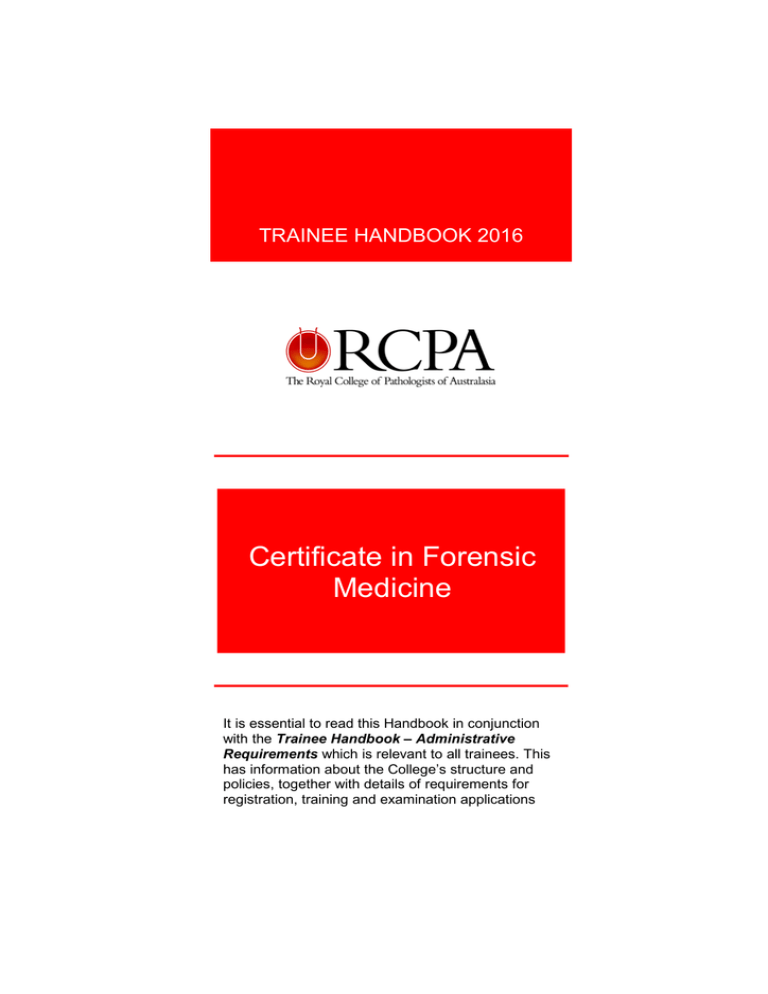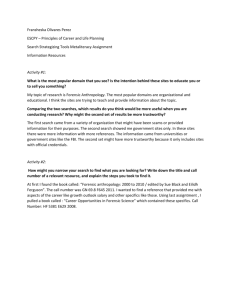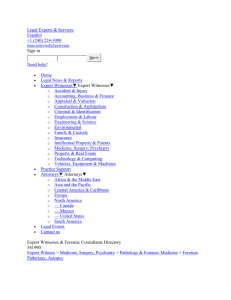Certificate in Forensic Medicine TRAINEE HANDBOOK 2016
advertisement

TRAINEE HANDBOOK 2016 Certificate in Forensic Medicine It is essential to read this Handbook in conjunction with the Trainee Handbook – Administrative Requirements which is relevant to all trainees. This has information about the College’s structure and policies, together with details of requirements for registration, training and examination applications RCPA Trainee Handbook - Certificate in Forensic Medicine C E R T I FI C AT E I N F OR E N S I C M E D I C I N E Please refer to the general requirements for training and examinations set out in the Trainee Handbook – Administrative Requirements INTRODUCTION As the Forensic Pathology Secretariat for the World Association of Societies of Pathology, the College has international responsibilities in forensic medicine generally and more specifically in forensic pathology. In discharging these responsibilities, one of the main contributions the College can make is to provide the framework for training opportunities that can lead to an appropriate qualification. It is anticipated many such trainees will come from countries where opportunities for training in pathology are limited, but the need for forensic pathologists exists. Such trainees may not fulfil the requirements for Fellowship of the College (or for the postFellowship Diploma in Forensic Pathology. The College has therefore instituted the Certificate in Forensic Medicine (Cert For Med) as a qualification for candidates not eligible for the Fellowship or post-Fellowship Diploma in Forensic Pathology. The Certificate in Forensic Medicine is set at a standard below that of the Fellowship and of the Diploma in Forensic Pathology, to provide some assurance of competence and analytical ability in the major areas of forensic pathology. The award of this Certificate has no implications for registration as a medical practitioner in Australia, because it is not the equivalent of the Fellowship, or of the post-Fellowship Diploma in Forensic Pathology. GENERAL INFORMATION Eligibility Criteria The Certificate in Forensic Medicine is offered to Australian and overseas medical graduates seeking a qualification in forensic pathology but who are not eligible to undertake the Fellowship. To be eligible, the candidate: Must hold a medical qualification acceptable to the RCPA Board of Education and Assessment. Must have practised in forensic medicine (including forensic pathology), in a medico-legal facility that is recognised by the Board of Education and Assessment, for a minimum of 3 years. Must have completed twelve (12) months of training at a centre accredited by the College for training in Forensic Pathology. This training must include certification of competence by the Head of the Department and at the time of application for the examination - in the following: (a) OH+S at the death scene, in the mortuary and in the laboratory (b) Quality systems in the mortuary and laboratory (c) Autopsy techniques including: o External examination o Opening head, chest, abdomen o Inspection and evisceration o Dissection and description © January 2016 The Royal College of Pathologists of Australasia Page 1 of 7 RCPA Trainee Handbook - Certificate in Forensic Medicine o Reconstitution of the body and (d) Special techniques including: o Interpretation of radiological examinations o Mortuary photography o Infant autopsies o Removal of spinal cord o Examination of vertebral arteries o Inspection of femoral bone marrow o Removal of cervical spine o Anthropological examination of skeletalised remains and (e) Experience in histopathology to an introductory level, enabling correct diagnosis of common findings at post-mortem examination (see Introductory Histopathology Curriculum, below). This standard is less than that required for a pass at the Part I examination in Forensic Pathology. and (f) The writing of autopsy reports; the principles of giving evidence in court; the principles of forensic science and the examination of scenes of death. and (g) Presenting and evaluating autopsy findings orally; or (h) Satisfies the Chief Examiner and the RCPA Board of Education and Assessment that he or she has experience in forensic pathology equivalent in aggregate and in all respects to twelve months of training in an accredited centre. This experience must be certified by an appropriate authority (e.g., Head of a Department of Forensic Pathology) and must include evidence of autopsy experience -- including forensic autopsies -- and other experience that encompasses the same areas referred to above. Must satisfactorily complete the assessments (portfolio and examinations – see below) At its discretion, the Board of Education and Assessment may take into account other training or experience (e.g., post-graduate degrees) in determining an individual’s eligibility for examination. As a general rule, a high degree of proficiency, relevance and certification must be proven for this other training or experience, to influence a decision to bypass any of the eligibility requirements above. Ordinarily, each candidate must be sponsored by a Fellow of the College. In circumstances where this is impracticable, the sponsorship of the Head of Department where the candidate is working may be accepted. Fellows sponsoring candidates for the Certificate in Forensic Medicine are advised to seek preliminary indications from the College before accepting an overseas graduate for training. © January 2016 The Royal College of Pathologists of Australasia Page 2 of 7 RCPA Trainee Handbook - Certificate in Forensic Medicine Those candidates who have completed the training requirements are eligible for immediate award of the Certificate on successful completion of the examination, including submission of an acceptable portfolio (see below). For those candidates who take the examination part-way during the training period, award of the Certificate is deferred until the training period is completed. INTRODUCTORY HISTOPATHOLOGY CURRICULUM FOR THE Cert For Med Candidates must have a clear understanding of the relevance and importance of microscopic examination of tissues as part of post-mortem examination of the body. This understanding should include knowledge of OH+S in the laboratory Tissue preservation and processing, including the cutting of sections H+E and common special stains including PAS, PAS(D), trichrome stain, PBR, ZN, Reticulin, myelin and axonal stains in the CNS, and the principles of immunoperoxidase. The list below gives some guidance to commonly encountered conditions in forensic autopsy practice, conditions that candidates for the Cert For Med should be able to assess and diagnose by microscopic examination. It is emphasised that knowledge of these conditions alone gives only an introductory level of diagnostic ability in forensic histopathology, and will not enable assessment and diagnosis of the full range of conditions that are likely to be encountered in routine forensic pathology practice. ALL ORGANS/TISSUES Normal histological morphology Infections - bacterial (e.g. TB, suppurative) - viral (e.g. CMV, Herpes) - fungal (e.g. Aspergillus) - parasitic (e.g. Hydatid) Amyloidosis Sarcoidosis Neoplasia - leukamic infiltrate - metastases Vasculitis Infarction/Ischaemia CARDIOVASCULAR SYSTEM Pericarditis Myocarditis (lymphocytic; granulomatous) Rheumatic endocarditis Infective endocarditis of heart valve Sarcoid heart disease Myocardial infarction Ischaemic heart disease Coronary arteriosclerosis +/- thrombosis Coronary artery vasculiltis RESPIRATORY SYSTEM Tracheitis and bronchitis Bronchopneumonia Lobar pneumonia Aspiration pneumonia Lung abscess © January 2016 The Royal College of Pathologists of Australasia Page 3 of 7 RCPA Trainee Handbook - Certificate in Forensic Medicine Chronic interstitial lung disease (eg asbestosis) ARDS Hyaline membrane disease of newborn Sarcoidosis IV microgranulomatosis Common cancers Malignant mesothelioms GASTROINTESTINAL SYSTEM Oesophagitis Gastritis Crohn’s disease Colitis Common cancers HEPATOBILIARY AND PANCREAS Hepatitis C Alcoholic steatohepatitis Haemachromatosis Cirrhosis Hydatid disease Common cancers Cholecystitis Pancreatitis GENITOURINARY SYSTEM APN/CPN Arteriosclerotic nephrosclerosis Diabetic nephrosclerosis Hypertensive nephrosclerosis Renal infarction ARTN Myoglobinuria Oxalate deposits Angiomyolipoma Common cancers – kidney; prostate Cystitis Prostatitis/prostatic abscess BPH ENDOCRINE SYSTEM Pituitary necrosis/infarction MNCG thyroid Hashimoto’s thyroiditis Adrenal cortical nodules Adrenal hypoplasia (Addison’s) Adrenal haemorrhage SKIN Electrical injury MUSCULOSKELETAL SYSTEM Healing fracture © January 2016 The Royal College of Pathologists of Australasia Page 4 of 7 RCPA Trainee Handbook - Certificate in Forensic Medicine CENTRAL NERVOUS SYSTEM Meningitis Encephalitis Cerebral abscess SDH Cerebral infarction Plaque jaune ASSESSMENT The assessment consists of summative and formative components: presentation of a portfolio of post-mortem examinations undertaken (200) and witnessed (200) by the candidate, a discussion of 10 of these cases, and essays on selected topics (see below); a three (3) hour short answer examination in the major areas of Forensic Pathology and Forensic Medicine, focussing particularly on the selected topics in the portfolio; a two (2) hour introductory histopathology examination of 10 cases; a two (2) hour practical examination (should any trainees be sitting for the Diploma in Forensic Pathology, a similar practical examination may be used for both examinations.); The examinations will be held over two (2) days mid-year, at the same time as other College examinations, or towards the end of the year if required (ordinarily the examinations will be taken towards the end of the candidates’ 12-month training attachment). All of the examinations can be taken in the region of training. Portfolio The portfolio will comprise three (3) components: a 150-word (approximately) de-identified summary of each case examined by the candidate a referenced discussion (approximately 1200 words) of 10 of the cases. These 10 cases should be selected from the case categories given in the “Casebook Requirements” section of the FP1 and FP2 curriculum chapter of the Trainees Handbook a 1200 word (approximately) essay on each of 24 selected topics in forensic medicine (see Appendix 1). Short Answer Examination The examination will require answers in short note form to common topics in forensic pathology and medicine (including anatomical pathology to an introductory level, as it applies to autopsy practice). Practical Examination The candidate will be required to examine illustrated colour photographs of forensic cases and possibly gross specimens of forensic and medical post-mortem significance. This may include a series of photographs, museum preparations and a series of cases. © January 2016 The Royal College of Pathologists of Australasia Page 5 of 7 RCPA Trainee Handbook - Certificate in Forensic Medicine Limited Examination for Certificate in Forensic Medicine There shall be no waiver of any part of the examination for any candidate. KNOWLEDGE AND EXPERIENCE TO BE ATTAINED Minimum of 200 supervised post-mortem examinations made by the candidate together with a further 200 cases witnessed by the candidate, with understanding of the aims of the examination and investigations in Coronial cases, including Natural deaths Suicides (hanging; CO toxicity; etc) Accidents (MVC’s; domestic; industrial; paediatric) Others (homicides; alcohol or drug-related; bodies in fires; bodies in water; SUDI; SUDEP; GSW’s; death with no definable pathology; decomposed bodies; industrial disease) Ability to plan the autopsy and its investigations based on the apparent circumstances of the death Application of standard autopsy protocols where these are available and suitable Ability to diagnose common gross findings Ability to integrate the post-mortem findings with the apparent circumstances of the death Ability to interpret various types of injuries, understanding how these may assist forensic investigation Diagnostic ability with H+E slides at an introductory level Application of associated investigations – forensic science; toxicology; clinical pathology Understanding of ethical, cultural and religious aspects of autopsy practice OH+S in the death scene, mortuary and laboratory Quality Systems in forensic medicine, including the types and usefulness of audits Introductory-level understanding of the Courts and relevant legislation, and deeper understanding of the responsibilities of expert medical witnesses Familiarity with the usefulness and interpretation of medical imaging in autopsy practice Understanding of disaster victim identification (DVI) including methods, quality issues and pitfalls AIDS IN THE ACQUISITION OF KNOWLEDGE See FP1 and FP2 curriculum in the Trainees Handbook. © January 2016 The Royal College of Pathologists of Australasia Page 6 of 7 RCPA Trainee Handbook - Certificate in Forensic Medicine APPENDIX 1: PORTFOLIO TOPICS The candidate is required to write a 1200-word (approximate) discussion on each of the 24 topics given below. Over the 12-month training attachment this allows 2 weeks for completion of each essay. Each essay should be assessed by the candidates’ supervisor and then e-mailed to the Chief Examiner for final assessment. The essay will be returned to the candidate for changes/corrections if not satisfactory. Satisfactory completion of each essay is required before the candidate has fulfilled this component of the assessment requirements. 1. 2. 3. 4. 5. 6. 7. 8. 9. 10. 11. 12. 13. 14. 15. 16. 17. 18. 19. 20. 21. 22. 23. 24. The Quality System – how it contributes to forensic practice. Overcoming hazards associated with Hepatitis C in the mortuary. A system of examination of the adult heart. Cardiomegaly in an adult – description of possible gross and microscopic findings. Radiology in forensic practice (plain X-rays and CT). Possible PM findings related to alcoholism. Possible PM findings in an IV drug user. A system of examination of the adult brain, including reasoning for selection of tissue blocks for possible microscopic examination. Types of mechanical injuries and how they may be forensically useful. Examination of the deceased who is a pedestrian victim of a “hit and run”. PM findings and investigation of suspected fatal anaphylaxis. Difficulties and PM findings in bodies recovered from water. Difficulties and PM finding in bodies recovered from a house fire. Estimation of time of death (post-mortem interval). Practical examples of how the forensic sciences may assist with death investigation. Explosive injuries. “Suspicious” injuries. SUDI – the special procedures in investigating deaths in infancy. Explain the following and to what each term applies in autopsy practice– Nutmeg; Icing sugar; Bread and butter; Anchovy sauce; Flea bitten; Cor bovinum; Chocolate cyst; Caseous; Strawberry; Walnut; Mulberry. Sudden death with no pathology identified: investigation. Distinguishing the different types of pneumonia. Neck dissection where there is suspected neck compression. Gunshot wounds – determining the range of fire. Examination of a female deceased victim for possible sexual assault. © January 2016 The Royal College of Pathologists of Australasia Page 7 of 7





